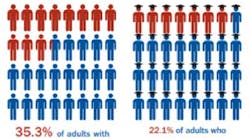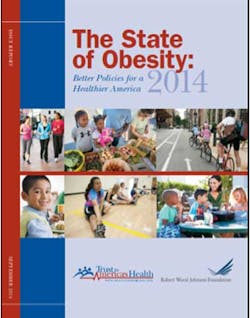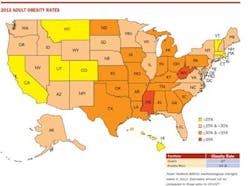Rates of adult obesity increased in six U.S. states, and decreased in no state in 2013. In 20 states, at least 30% of adults are obese. By comparison, from 2011 to 2012, the rate of obesity increased in only one state. This was reported by the Trust for America's Health and the Robert Wood Johnson Foundation, and the report was based on federal government data.(1) Some facts about obesity – 40.7% of Latino boys are obese or overweight compared with 27.8% of Caucasian boys; 10.1% of African-American boys are severely obese compared with 3.3% of Caucasian boys; and nearly 40% of American adults ages 40 to 59 are obese.(2)
The 2013 adult obesity rate exceeds 20% in every state, while 42 have rates above 25%. For the first time two states – Mississippi and West Virginia – rose above 35%. The year before, 13 states were above 30% and 41 states had rates of at least 25%.(1) Nine of the 10 states with the highest rates of obesity are in the South. The West and Northeast had the healthiest BMIs, with Colorado boasting the lowest adult obesity rate at 21.3%.
Also in nutrition news, a new study published in the Centers for Disease Control and Prevention (CDC) journal Preventing Chronic Disease, finds that trans fat is still present in many foods, even in those that make the “0 grams” claim.(3) While there are signs that consumption of trans fat has declined in the U.S., limited documentation exists on current levels of industrial trans fat in foods.
The study estimated the prevalence of partially hydrogenated oils in 4,340 top-selling U.S. packaged foods. Nine percent of products in the sample contained partially hydrogenated oils, 84% of these products listed “0 grams” of trans fat per serving, which could potentially lead consumers to underestimate their trans fat consumption.(3) Government efforts to eliminate partially hydrogenated oils from packaged foods will substantially reduce exposure to this known cardiovascular disease risk factor. Trans fat consumption is a risk factor for cardiovascular disease.(4)
Another new study found that a low carb diet is more effective for weight loss and cardiovascular risk factor reduction than the low fat diet. Restricting carbs may be an option for people wanting to lose weight and reduce cardiovascular risk factors.(5) There is robust evidence that individuals can severely reduce their heart disease risk by eating fewer carbs and more dietary fat, with the exception of trans fats. This National Institutes of Health (NIH)-funded study proposes that this strategy more effectively reduces body fat and also lowers overall weight.
Bottom line, this research suggests that health authorities should move from fat restrictions and encourage people to eat fewer processed foods, particularly those with refined carbohydrates.
Maria Perno Goldie, RDH, MS, is the editorial director of RDH eVillage FOCUS.
References
1. The State of Obesity. Better Policies for a Healthier America 2014. http://healthyamericans.org/assets/files/TFAH-2014-ObesityReport-Fnl10.9.pdf
2. http://stateofobesity.org/
3. Clapp J, Curtis CJ, Middleton AE, Goldstein GP. Prevalence of Partially Hydrogenated Oils in US Packaged Foods, 2012. Prev Chronic Dis 2014;11:140161. DOI: http://dx.doi.org/10.5888/pcd11.14016
4. Mozaffarian D, Katan MB, Ascherio A, et al. Trans fatty acids and cardiovascular disease. N Engl J Med 2006;354(15):1601–13
5. Bazzano LA, Hu T, Reynolds K. Effects of Low-Carbohydrate and Low-Fat Diets: A Randomized Trial. Ann Intern Med. 2014;161 (5):309-318. doi:10.7326/M14-0180










